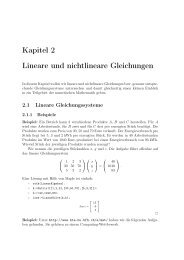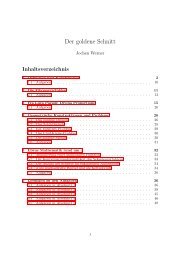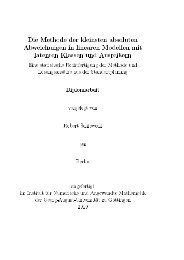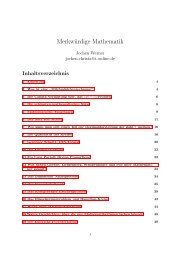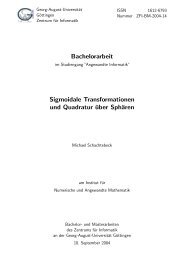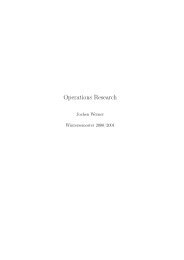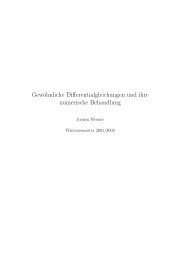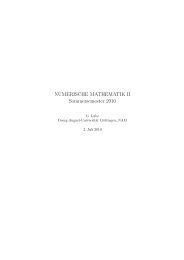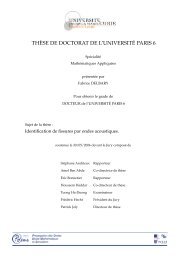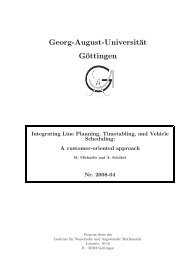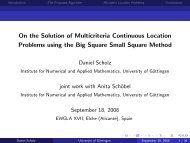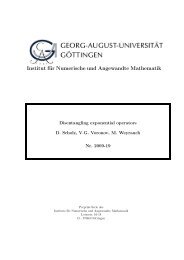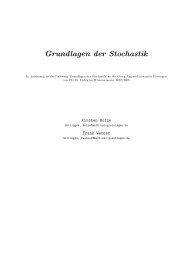BAIL 2006 Book of Abstracts - Institut für Numerische und ...
BAIL 2006 Book of Abstracts - Institut für Numerische und ...
BAIL 2006 Book of Abstracts - Institut für Numerische und ...
You also want an ePaper? Increase the reach of your titles
YUMPU automatically turns print PDFs into web optimized ePapers that Google loves.
M. HÖLLING, H. HERWIG: Computation <strong>of</strong> turbulent natural convection at vertical<br />
walls using new wall functions<br />
✬<br />
✫<br />
Computation <strong>of</strong> turbulent natural convection at vertical walls using new wall<br />
functions<br />
M. Hölling, H. Herwig<br />
Technical Thermodynamics<br />
Hamburg University <strong>of</strong> Technology<br />
Denickestraße 15, 21073 Hamburg, Germany<br />
m.hoelling@tu-harburg.de<br />
h.herwig@tu-harburg.de<br />
Turbulent natural convection at vertical walls has been <strong>und</strong>er investigation in the last decades<br />
but is still not sufficiently <strong>und</strong>erstood. The viscous sublayer, i.e. the region very close to the wall,<br />
can be described properly, see e.g. Tsuji and Nagano [1], since there the turbulent fluctuations<br />
are damped by the wall and the governing equations can be solved directly. But in the more<br />
interesting region in which turbulence dominates, the flow cannot be described properly. George<br />
and Capp [2] <strong>of</strong>fer analytical temperature and velocity pr<strong>of</strong>iles which have become a kind <strong>of</strong><br />
standard for natural convection. But, it was shown by Versteegh and Nieuwstadt [3] and by<br />
Henkes and Hoogendoorn [4] that at least the velocity pr<strong>of</strong>ile is erroneous. We employ a different<br />
approach presented in Hölling and Herwig [5] to describe the turbulence affected region <strong>of</strong> the<br />
flow field.<br />
The starting point for the analysis is a channel with a hot and a cold wall <strong>of</strong> infinite extent<br />
as used by Versteegh and Nieuwstadt [3] for their DNS study. The governing equations then<br />
reduce to:<br />
0 = ∂<br />
�<br />
∂y<br />
0 = ∂<br />
∂y<br />
∂y − v′ T ′<br />
�<br />
a ∂T<br />
�<br />
ν ∂u<br />
∂y − u′ v ′<br />
�<br />
+ gβ � �<br />
T − T0<br />
It is fo<strong>und</strong> that the temperature field consists <strong>of</strong> a viscosity influenced wall layer and a fully<br />
turbulent outer layer. The temperature pr<strong>of</strong>ile is obtained by matching <strong>of</strong> gradients between<br />
these layers that reveals a logarithmic pr<strong>of</strong>ile. It is in good agreement with DNS as well as<br />
experimental temperature pr<strong>of</strong>iles from various studies.<br />
For the velocity pr<strong>of</strong>ile a different approach is chosen; the pr<strong>of</strong>ile is not obtained by matching<br />
<strong>of</strong> gradients. Instead the momentum equation (2) is rewritten in such a way that the temperature<br />
pr<strong>of</strong>ile and the Reynolds stresses are expressed as a function <strong>of</strong> the wall distance. The Reynolds<br />
stresses are modelled using the eddy viscosity approach. A constant turbulent Prandtl number<br />
is assumed as can be concluded from DNS data. Then the eddy viscosity is directly linked to the<br />
turbulent thermal diffusivity and therefore is a linear function <strong>of</strong> wall distance. Once all terms<br />
are expressed as a function <strong>of</strong> wall distance the momentum equation can be integrated and a<br />
velocity pr<strong>of</strong>ile emerges. This pr<strong>of</strong>ile is in good agreement with DNS and experimental data.<br />
Straightforward numerical solutions without adequate near wall treatment, like with FLU-<br />
ENT 6.2, to reproduce the DNS data <strong>of</strong> Versteegh and Nieuwstadt [3] for Ra = 5.0 · 10 6 show<br />
that even with fine grids also in the viscous sublayer only poor agreement can be achieved.<br />
Thus, we conclude that it would be diserable to have a new approach and improved near wall<br />
treatment.<br />
Therefore, we apply the new universal pr<strong>of</strong>iles as wall functions for CFD calculations. They<br />
are implemented in the two dimensional CAFFA code <strong>of</strong> Ferziger and Peric [6] that uses the kω-turbulence<br />
model and the Boussinesq-approximation. The standard k-ω model is used inspite<br />
Speaker: HÖLLING, M. 91 <strong>BAIL</strong> <strong>2006</strong><br />
1<br />
(1)<br />
(2)<br />
✩<br />
✪



